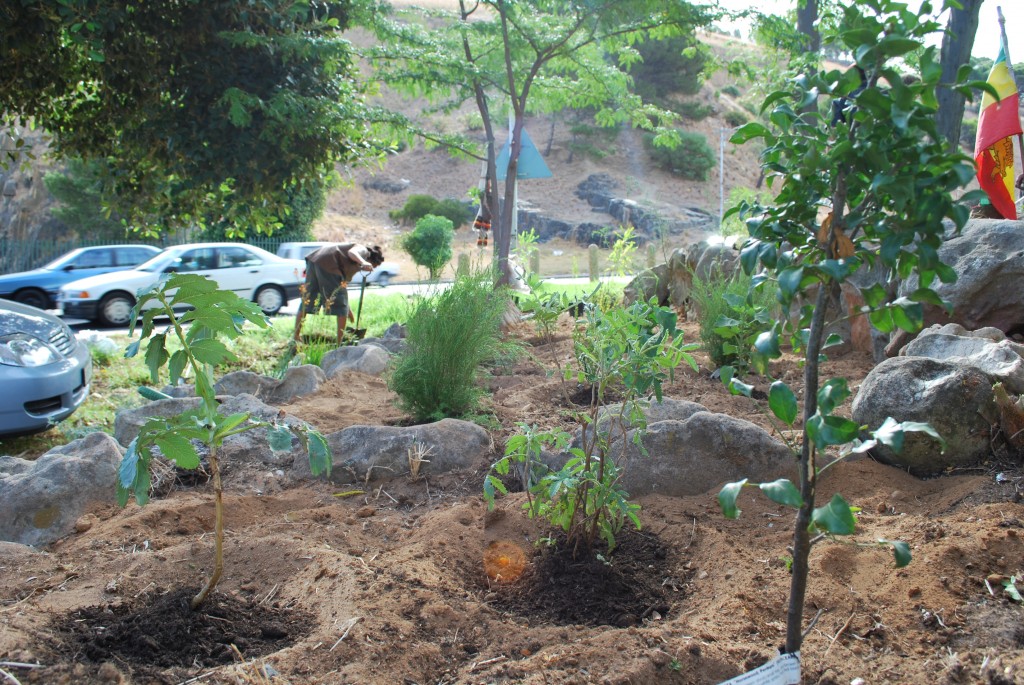
Between the 21st of January and the 13th of March 2010 we were invited to conduct a three-week research residency in Cape Town. ‘The naming and claiming of space’ began by investigating the way in which locations in Cape Town have been repeatedly renamed, revealing historic and contemporary demographics of power, culture and segregation, before looking in more detail at the lack of conventionally mapped references to Cape Town’s indigenous heritage. The residency culminated in a series of site-specific interventions and events that took place during the Infecting the City festival.
Activity #3: The herb gardens
In collaboration with the Khoe San Active Awareness Group we decided that we wanted to plant four medicinal herb gardens, at sites where indigenous people were once executed or tortured by colonial settlers. Members of the local Khoe community refer to these spaces as sacred sites that need to undergo a process of healing and reconciliation. Each herb garden would facilitate this process, becoming a living memorial to the events that took place, while celebrating the wealth of indigenous knowledge regarding the medicinal properties of wild herbs that grow in the Western Cape.
The local Khoi community would be responsible for the planting, maintenance and naming of each site, and we hope that each memorial will eventually be recognised by the city of Cape Town, and included on future cartographic representations of the city.
Memorial sites (listed in the order that they were used as places of execution):
1. A patch of grass in front of the westerly corner of the castle (Buitenkant/Darling Street)
STATUS: Permission denied.
2. In a small park opposite the ‘Strand Street Quarry’ (Strand Street).
STATUS: Planted as an act of guerrilla gardening.
3. The site historically referred to as Gallows Hill (Ebenezer Road/Somerset Road).
STATUS: An invitation to collaborate with the architects currently developing the area.
4. The Cape Town archives (Roeland Street).
STATUS: Pending. A decision will be made following further deliberations.
Strand Street
Planted on the 15th of February
The first herb garden was planted on Strand Street on Monday the 15th of February. We are not 100% sure if this location refers to the exact site of execution, but it was probably very nearby. In an interesting addition to the history of the site, one of the neighbours pointed out what appear to be the traces of a train track running alongside the new herb garden. She described these tracks as those that were once used to transport stone from the slave-powered quarry, down to the castle below.
The finished garden was much bigger than we had expected, uncovering an existing frame of overgrown stonework to create a terraced garden that probably completed the original plan for the site. Judah & Levi from the Franschoek Medicinal Herb Garden led the process of planting with a wealth of horticultural expertise (and few words!).
The site was dedicated to Sara Baartman, and a plaque was made that read: This indigenous herb garden was planted by the Khoe and San community of Cape Town to facilitate the process of healing and reconciliation at a former site of execution and torture.
It was nice to see how the project seemed to receive so much support from the local community, who quickly offered to provide a future supply of water and keep an eye on the garden’s progress.
Gallows Hill
An invitation to collaborate with the architects currently developing the area
Potentially the most exciting development of the whole project came while trying to gain permission to plant a herb garden at the site historically referred to as ‘gallows hill’, now a car park being redeveloped as a ‘non-motorised transport hub’ for the World Cup. Due to the building work we were unable to plant the herb garden during the festival, but we did manage to persuade the architects and the city-planning department to invite the Khoe and San community to play an active role in the redevelopment of the area. A preliminary meeting looked at current plans for the area, discussed where the herb garden could be planted, agreed that the planning department would cover the costs of planting the garden, and set a timeframe for future developments.
In addition the existing plan to erect a series of information plaques relating to Cape Town’s heritage were discussed, with the planning department agreeing in principle to the idea of creating an extra (at present non-existent) plaque, that would focus on the indigenous people of the Western Cape. The Khoe San Active Awareness Group has been asked to liaise directly with the city heritage department to realise this project.
All of this was much more than we had ever hoped to achieve. An opportunity for the indigenous community of Cape Town to be directly involved in city planning processes, and the way in which the heritage of Cape Town is presented to the public. We only hope that Bradley van Sitters and the Khoe San Active Awareness Group find the necessary support to ensure that this opportunity does not go to waste.
Herb exhibition
Wednesday the 17th of February
An exhibition of medicinal herbs was hosted by Simeon Goldstone and Naftali Bushwak and presented at the castle, the one location where our request to plant an indigenous herb garden had been categorically denied. The memorial text was printed onto T-Shirts that were worn for the intervention.


